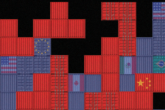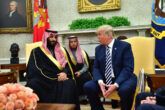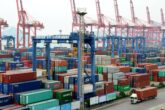December 17, 2020
America’s Use of Coercive Economic Statecraft
Report from Select Members of the CNAS Task Force on the Future of U.S. Coercive Economic Statecraft
With John Bellinger, Howard Berman, Chad Bown, David Cohen, Hank Corscadden, Heidi Crebo-Rediker, Wendy Cutler, Paula Dobriansky (Task Force Co-Chair), David Dollar, Daniel Drezner, Elizabeth Economy, Richard Fontaine, Todd Fox, Brian Grant, Carlton Greene, Carlos Gutierrez (Former Task Force Co-Chair), Peter Harrell (Principal Co-Author), Jennifer Hillman, John Hughes, Theodore Kassinger, Aimen Mir, Richard Nephew, Alexander Niejelow, Catherine Novelli, Christopher Padilla, William Reinsch, Frederick Reynolds, Elizabeth Rosenberg (Principal Co-Author), Lisa Sawyer, Rober Scher, Vance Serchuk, Daleep Singh, John Smith, Adam Szubin (Task Force Co-Chair), Jay Thompson, Todd Tucker, Candida P. Wolff, Juan Zarate, and Rachel Ziemba
Key Takeaways
- U.S. policymakers will continue to intensively use a growing array of coercive economic tools, including tariffs, sanctions, trade controls, and investment restrictions. The growing use reflects a desire by policymakers to use coercive economic tools in support of a growing range of policy objectives.
- Diplomacy around these tools has long been challenging and can require hard choices. To use these tools effectively, policymakers should focus on articulating clear objectives and measuring effectiveness and costs. U.S.-China competition raises the stakes for getting the use of coercive economic statecraft right.
- Policymakers in the next presidential administration and Congress would be well-served to spend at least as much effort focusing on the positive tools of statecraft. These include domestic economic renewal, international finance and development incentives, and positive trade measures, among others.
The Rapid Evolution of America’s Use of Coercive Economic Tools
The last decade has seen an explosive growth in U.S. coercive economic tools. Under the George W. Bush and Barack Obama administrations, innovation in the coercive economic toolkit was primarily, although not exclusively, in the domain of U.S. sanctions. These administrations expanded sanctions on Iran in unprecedented ways, invented new types of financial restrictions on Russia, and targeted a growing array of transnational threats. Under Donald Trump’s administration, America has not only continued to expand its use of sanctions, it has also renewed and expanded other parts of America’s coercive economic toolkit. The United States has introduced new types of export controls, restrictions on foreign investment in the country, tariffs, efforts to ban the distribution of foreign-owned apps, and other limits on imports.
America’s expanding coercive economic toolkit serves a growing array of policy objectives. For decades, U.S. sanctions have been deployed to target the proliferation of weapons of mass destruction (WMD); military aggression by adversaries; terrorism; narcotics trafficking; and mass atrocities, repression, and other serious violations of human rights. But the United States has begun to use sanctions to pursue a wider range of targets, including cybercrime, intellectual property theft, and even the International Criminal Court. More notably, the country has begun to use its growing array of non-sanctions coercive economic measures to pursue a wide array of objectives. For example, the United States has imposed tariffs on steel and aluminum imports on the reasoning that high volumes of imports threaten U.S. national security—the first time the country has imposed so-called Section 232 tariffs in decades (though Section 232 tariffs have historically been used on multiple occasions). With broad bipartisan support, the United States has tightened restrictions on investment in the United States to ensure that competitors, particularly Chinese firms, cannot acquire key U.S. technology. Also, the United States is increasingly deploying export controls and other coercive tools in its technological and economic competition with China, seeking to limit Chinese technology companies’ global reach and ability to overcome U.S. and allied firms’ technological advantage.
America’s expanding coercive economic toolkit serves a growing array of policy objectives.
Of course, the U.S. toolkit to address these challenges is not only coercive. Particularly in the wake of the COVID-19 pandemic, U.S. policymakers have also begun to contemplate industrial policies, such as subsidies for U.S. semiconductor firms and localizing supply chains of critical materials within the United States. The United States has also expanded its diplomatic outreach and activities around economic issues, particularly in Asia, where it has sought to build cooperation to counter China’s economic and national security threats around shared concerns. While both domestic investments and coercive tools used internationally are critical for U.S. security, this brief examines the dynamic and evolving domain of U.S. coercive economic tools and how they are used.
About the CNAS Task Force on the Future of U.S. Coercive Economic Statecraft
In July 2019, the Center for a New American Security (CNAS) launched its Task Force on the Future of U.S. Coercive Economic Statecraft, consisting of former senior U.S. officials, private sector representatives, and academic and think tank experts. It examined emerging trends, such as the growing use of export controls and other trade restrictions; the role of energy in coercive economic statecraft; trans-Atlantic cooperation and disagreement on these measures; and developments in U.S.-China economic relations and the prospects for economic decoupling. During 2019 and 2020, the task force hosted a range of high-level government officials and distinguished thought leaders.
Task force members analyzed key trends in U.S. coercive economic statecraft and global developments that could potentially affect U.S. economic strength and statecraft in the future. This brief describes the most important of those trends and offers concise summaries of issues that national security policymakers should consider.
The below members of the task force have publicly signed on to the findings of the report. They do so in their individual capacity; they do not speak for any institutions with which they are affiliated:
| John Bellinger | Carlton Greene | Lisa Sawyer |
| Howard Berman | Carlos Gutierrez, Former Task Force Co-Chair | Robert Scher |
| Chad Bown | Peter Harrell, Principal Co-Author | Vance Serchuk |
| David Cohen | Jennifer Hillman | Daleep Singh |
| Hank Corscadden | John Hughes | John Smith |
| Heidi Crebo-Rediker | Theodore Kassinger | Adam Szubin, Task Force Co-Chair |
| Wendy Cutler | Aimen Mir | Jay Thompson |
| Paula Dobriansky, Task Force Co-Chair | Richard Nephew | Todd Tucker |
| David Dollar | Alexander Niejelow | Candida P. Wolff |
| Daniel Drezner | Catherine Novelli | Juan Zarate |
| Elizabeth Economy | Christopher Padilla | Rachel Ziemba |
| Richard Fontaine | William Reinsch | |
| Todd Fox | Frederick Reynolds | |
| Brian Grant | Elizabeth Rosenberg, Principal Co-Author |
Download the full report.
More from CNAS
-
Game Over?
The trade wargame suggests that sustained high tariffs could create leverage and urgency to spur action toward a productive restructuring of the international trade system....
By Emily Kilcrease & Geoffrey Gertz
-
Middle East Security / Energy, Economics & Security
Trump Inks $600 Bn Deal In Saudi Arabia | Musk, Blackrock CEO Flank Trump In Gulf VisitIn today's episode of India Global, U.S. President Donald Trump secured a $600 billion commitment from Saudi Arabia on Tuesday to invest in the United States. NDTV's Gaurie Dw...
By Daniel Silverberg
-
Energy, Economics & Security / Technology & National Security
Tariffs and Tech: An Uncertain RecipeHigher tariffs could prompt American cloud companies to shift more of their capital investments abroad....
By Pablo Chavez
-
Trump Tariffs: How Will U.S. Plans Reshape the Global Economy?
Donald Trump says he's already decided the tariffs he will impose on countries that export goods to America, including the United Kingdom. Channel 4 hears from Emily Kilcrease...
By Emily Kilcrease








